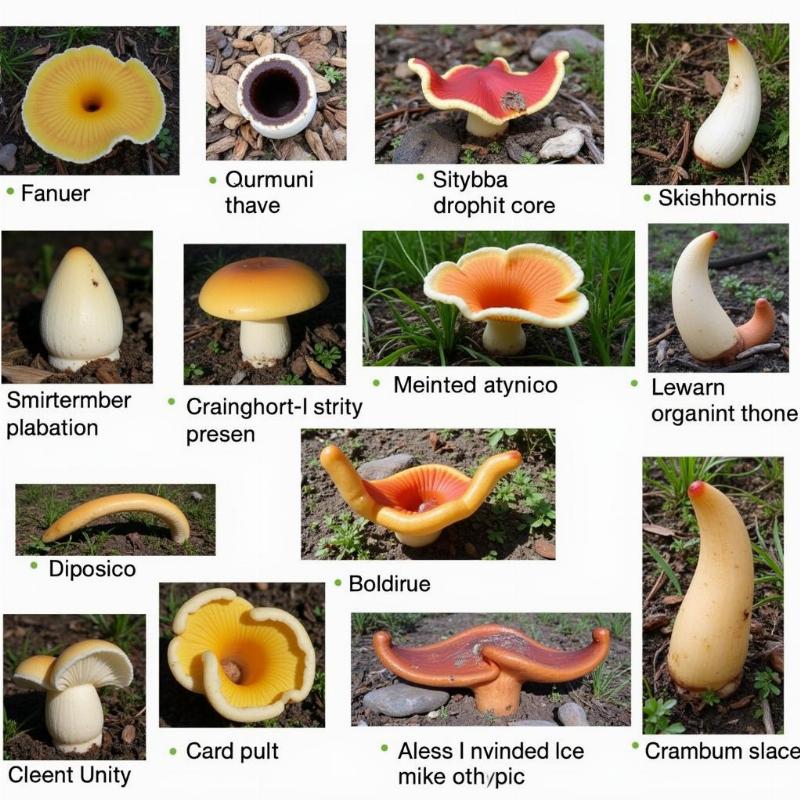Stinkhorn fungus, with its unsettling appearance and foul odor, is a common sight in yards and gardens across the US. If you’re a dog owner, you’ve likely wondered, “is stinkhorn fungus poisonous to dogs?” The short answer is: while generally not deadly, stinkhorn fungus can cause gastrointestinal upset in dogs and should be avoided. This article will delve into the specifics of stinkhorn fungus toxicity in dogs, explain what to do if your dog ingests it, and provide preventative measures to keep your furry friend safe.
Understanding Stinkhorn Fungus and its Potential Dangers
Stinkhorns belong to the Phallaceae family and are recognized by their unique, often phallic shape and pungent, rotting meat-like smell. This odor attracts flies and other insects which aid in spore dispersal, ensuring the fungus’ continued proliferation. While the mature fruiting body is the most recognizable form, stinkhorn fungus begins as an egg-like structure partially buried in the soil.
The primary concern with stinkhorn fungus and dogs lies in its sticky, spore-laden gleba, the slimy coating on the mature fungus. This gleba contains several compounds, some of which can cause gastrointestinal distress in dogs ranging from mild drooling and vomiting to more severe diarrhea. Though rarely life-threatening, these symptoms can be quite unpleasant for your pet.
What to Do if Your Dog Eats Stinkhorn Fungus
If you witness your dog consuming stinkhorn fungus, or suspect they have, it’s essential to monitor them closely for any signs of illness. The severity of the reaction can vary depending on the amount ingested and the individual dog’s sensitivity.
- Mild Cases: If your dog exhibits mild symptoms such as excessive drooling, lip-smacking, or a single episode of vomiting, monitor them closely and ensure they have access to fresh water. These symptoms often resolve on their own.
- Moderate to Severe Cases: If your dog experiences repeated vomiting, diarrhea, lethargy, loss of appetite, or any other concerning symptoms, contact your veterinarian immediately. They may recommend inducing vomiting or providing supportive care depending on the severity of the case.
Preventing Stinkhorn Fungus Exposure in Dogs
The best way to protect your dog from the unpleasant effects of stinkhorn fungus is to prevent exposure altogether. Here are some preventative measures:
- Regular Yard Checks: Regularly inspect your yard and garden for stinkhorn fungus, particularly after periods of rain. Remove and dispose of any fungus you find immediately.
- Training and Supervision: Train your dog to “leave it” on command. This command can be invaluable in preventing them from investigating and consuming potentially harmful substances like stinkhorn fungus. Supervise your dog closely when they are outdoors, especially in areas where stinkhorn fungus is known to grow.
- Muzzling: If your dog has a strong scavenging instinct and training proves ineffective, consider using a muzzle during outdoor excursions. This can prevent them from ingesting not only stinkhorn fungus but other potentially harmful items as well.
Identifying Stinkhorn Fungus
Knowing what to look for is crucial for effective prevention. Stinkhorns can vary in appearance depending on the species, but share common characteristics:
- Shape: Often phallic or cylindrical in shape.
- Color: Typically white, pink, or orange.
- Odor: A strong, foul odor resembling rotting meat.
- Gleba: A sticky, dark-colored, spore-containing slime that covers part of the mature fungus.
 Identifying stinkhorn fungus
Identifying stinkhorn fungus
Conclusion
While stinkhorn fungus is not typically deadly for dogs, its ingestion can cause gastrointestinal upset. By being vigilant, taking preventative measures, and knowing what to do in case of ingestion, you can protect your canine companion from this unpleasant encounter. Regularly checking your yard, training your dog, and knowing how to identify stinkhorn fungus are key steps in safeguarding your dog’s health and well-being.
FAQs
- Can stinkhorn fungus kill my dog? While extremely rare, severe cases involving a large amount of ingested fungus can lead to complications. It’s always best to err on the side of caution and contact your vet.
- What are the first signs my dog ate stinkhorn fungus? Excessive drooling, lip-smacking, vomiting, and diarrhea are common signs.
- How do I get rid of stinkhorn fungus in my yard? Remove the fungus, including the underground “egg” and dispose of it in a sealed bag.
- Are all mushrooms poisonous to dogs? No, not all mushrooms are poisonous, but it’s best to prevent your dog from eating any wild mushrooms as they can be difficult to identify.
- What should I do if my dog ate a large amount of stinkhorn fungus? Contact your veterinarian immediately.
- Can I use a home remedy to treat my dog after stinkhorn ingestion? No, consult your veterinarian before administering any treatment.
- How long do stinkhorn fungus symptoms last in dogs? Symptoms typically resolve within 24-48 hours with proper care.
Beautdogs.us is your premier source for dog lifestyle information in the US. We offer expert advice on dog breeds, care, and product recommendations. Whether you’re a seasoned dog owner or just starting your journey with a furry friend, Beautdogs.us is here to support you. Contact us at [email protected] or call +1 501-555-7529 for all your dog-related inquiries.